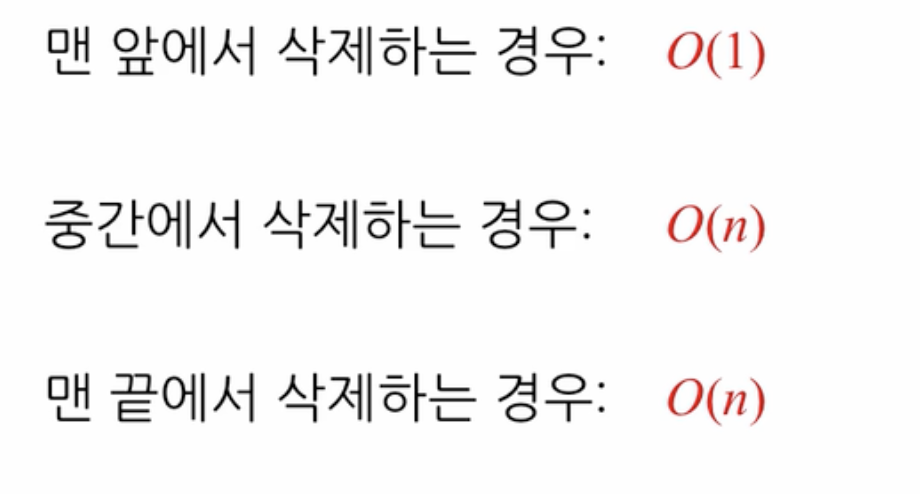6강 알고리즘 복잡도(Complexity of Algorithms)
시간 복잡도(Time Complexity)
문제의 크기와 이를 해결하는 데 걸리는 시간 사이의 관계
공간 복잡도(Space Complexity)
문제의 크기와 이를 해결하는 데 필요한 메모리 공간 사이의 관계
평균 시간 복잡도(Average Time Complexity)
임의의 입력 패턴을 가정했을 때 소요되는 시간의 평균
최악 시간 복잡도(Worst-case Time Complexity)*
가장 긴 시간을 소요하게 만드는 입력에 따라 소요되는 시간
Big-O Notation
점근 표기법의 하나, 어떤 함수의 증가 양상을 다른 함수와의 비교로 표현
1) 선형 시간 알고리즘 - O(n)
- 선형 탐색 알고리즘
2) 로그 시간 알고리즘 - O(logn)
- 이진 탐색 알고리즘
3) 이차 시간 알고리즘 - O(n2)
- 삽입 정렬의 Worst case
4) n로그 시간 알고리즘 - O(nlogn)
- 병합 정렬
7강 연결 리스트 (Linked Lists) - 1
추상적 자료구조
자료구조의 내부 구현은 숨겨두고 외부 구현(데이터, 연산)
기본적 연결 리스트

- Node
1. Data: 문자열, 레코드, 또 다른 연결 리스트 등 다양한 구조로 이루어질 수 있음
2. Link (next)
class Node:
def __init__(self, item):
self.data = item
self.next = Noneclass LinkedList:
def __intit__(self):
self.nodeCount = 0
self.head = None
self.tail = None
1. 특정 원소 참조 (k번째)
def getAt(self, pos):
if pos <= 0 or pos > self.nodeCount:
return None
i = 1
curr = self.head
while i < pos:
curr = curr.next
i += 1
return curr
| 배열 | 연결 리스트 | |
| 저장 공간 | 연속한 위치 | 임의의 위치 |
| 특정 원소 지칭 | 매우 간편 | 선형탐색과 유사 |
| O(1) | O(n) |
2. 리스트 순회
def traverse(self):
curr = self.head
result = []
while curr is not None:
result.append(curr.data)
curr = curr.next
return result
3. 길이 얻어내기
def getLength(self):
return self.NodeCount8강 연결 리스트 (Linked Lists) - 1
4. 원소 삽입

1. pos전 노드를 찾아 prev에 저장
2. newNode의 next를 pos로 설정
3. prev노드의 next를 newNode로 설정
4. NodeCount += 1
def insertAt(self, pos, newNode):
# 성공, 실패에 따라 True/False를 리턴
if pos < 1 or pos > self.newCount + 1:
return False
# 1. 삽입하려는 위치가 리스트 맨 앞일 때
## prev 없음
## Head 조정 필요
if pos == 1:
newNode.next = self.head
self.head = newNode
# 일반적인 경우
# pos가 가리키는 위치에 (1<= pos <= nodeCount + 1)
else:
if pos == self.nodeCount + 1:
prev = self.tail
else:
prev = self.getAt(pos-1)
# newNode를 삽입하고
newNode.next = prev.next
prev.next = newNode
# 2. 삽입하려는 위치가 리스트 맨 끝일 때
## Tail 조정 필요
if pos == self.nodeCount + 1:
self.tail = newNode
self.nodeCount += 1
return True
5. 원소 삭제

1. prev, curr 설정
2. prev.next = curr.next
3. result = curr
4. nodeCount -= 1
def popAt(self, pos):
if pos < 1 or pos > self.nodeCount:
raise IndexError
if pos == 1:
curr = self.head
self.head = curr.next
if self.nodeCount == 1:
self.tail = None
else:
curr = self.getAt(pos)
prev = self.getAt(pos-1)
prev.next = curr.next
result = curr.data
if pos == self.nodeCount:
if pos == 1:
self.tail = None
self.head = None
else:
self.tail = prev
self.nodeCount -= 1
return result

6. 두 리스트 합치기
연결 리스트 self의 뒤에 또 다른 연결 리스트인 L을 이어 붙임

def concat(self, L):
self.tail.next = L.head
if L.tail:
self.tail = L.tail
self.nodeCount += L.nodeCount
'ALGORITHM' 카테고리의 다른 글
| 프로그래머스 | 스킬트리 (Python) (0) | 2024.10.01 |
|---|---|
| 프로그래머스 | 타겟 넘버 (Python) (0) | 2024.10.01 |
| 어서와! 자료구조와 알고리즘은 처음이지? | 1강, 2강, 3강, 4강, 5강 (3) | 2024.09.24 |
| 프로그래머스 | 2022 KAKAO BLIND RECRUITMENT | 신고 결과 받기 (Python) (1) | 2024.09.21 |
| 프로그래머스 | 2023 KAKAO BLIND RECRUITMENT | 이모티콘 할인행사 (1) | 2024.09.20 |
